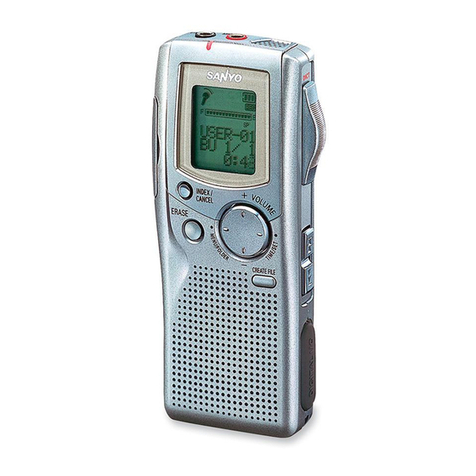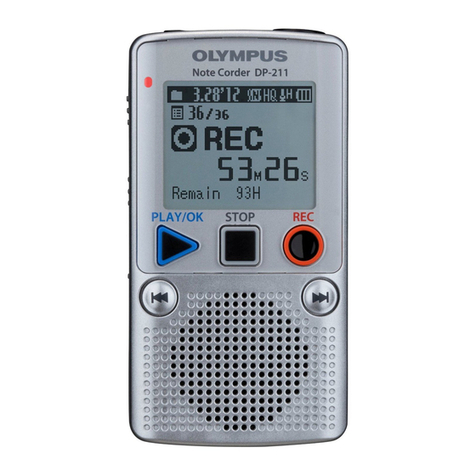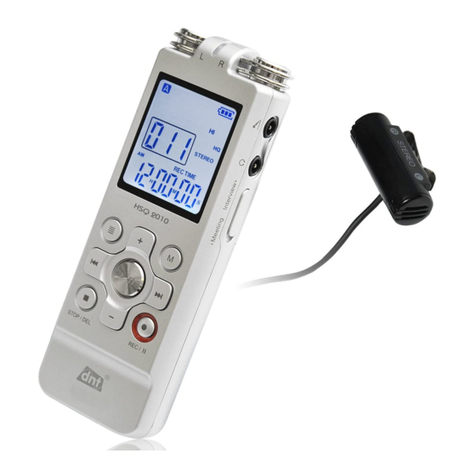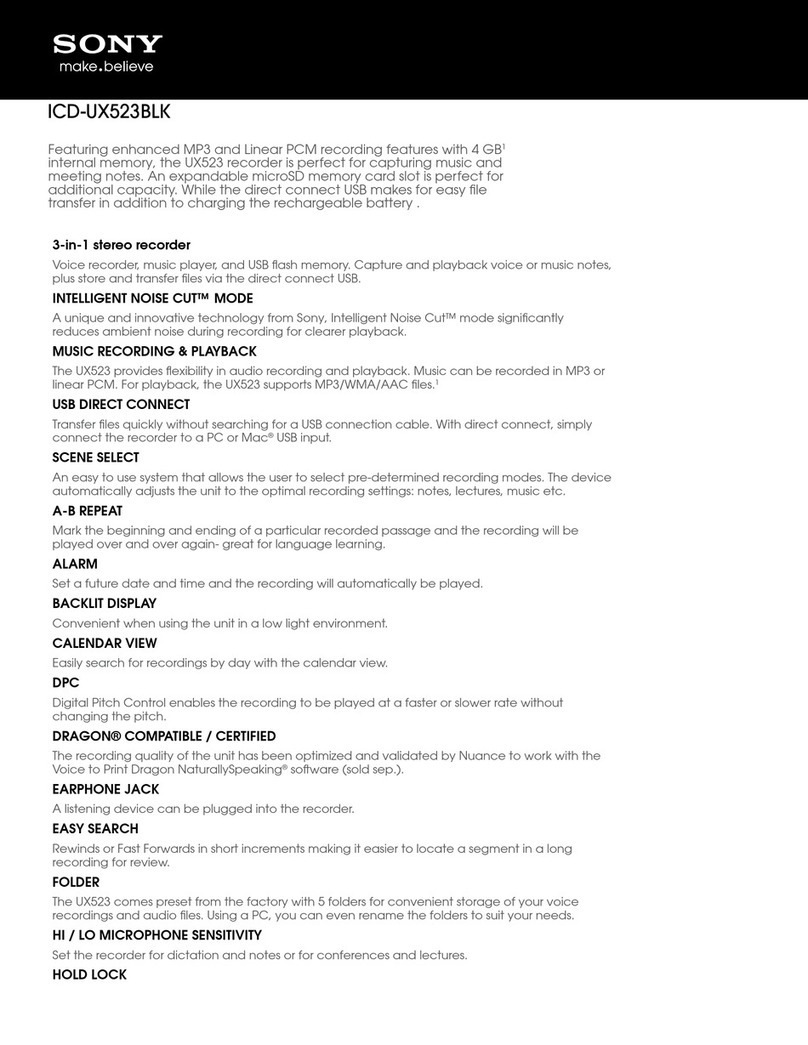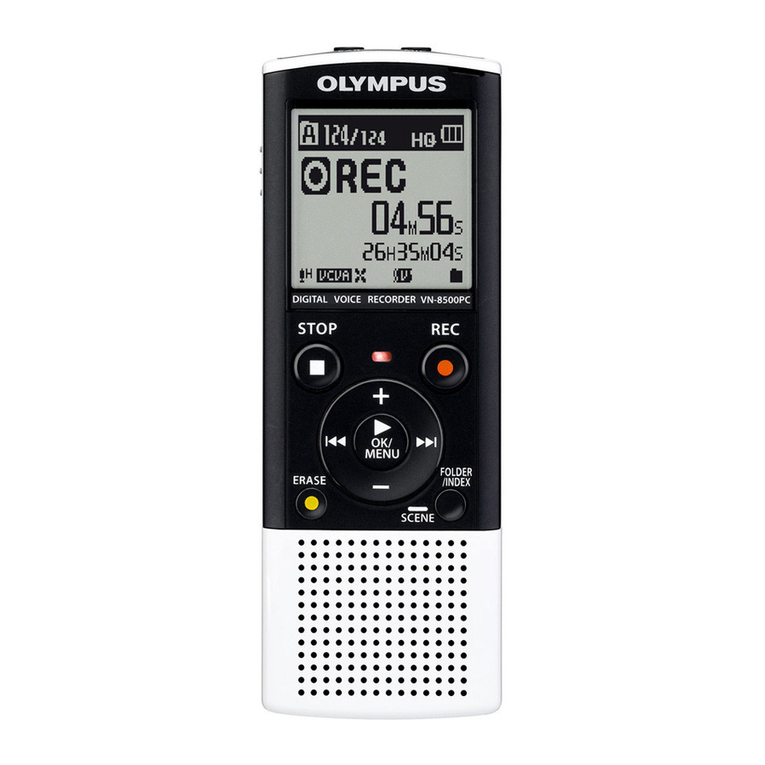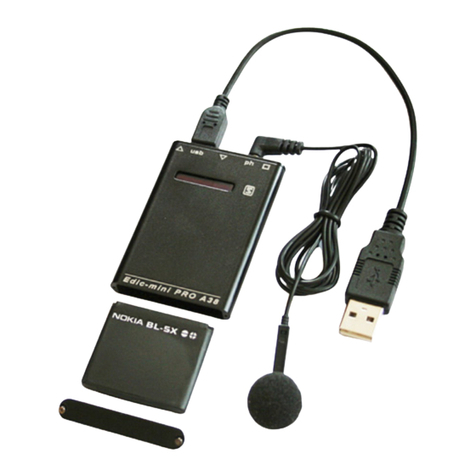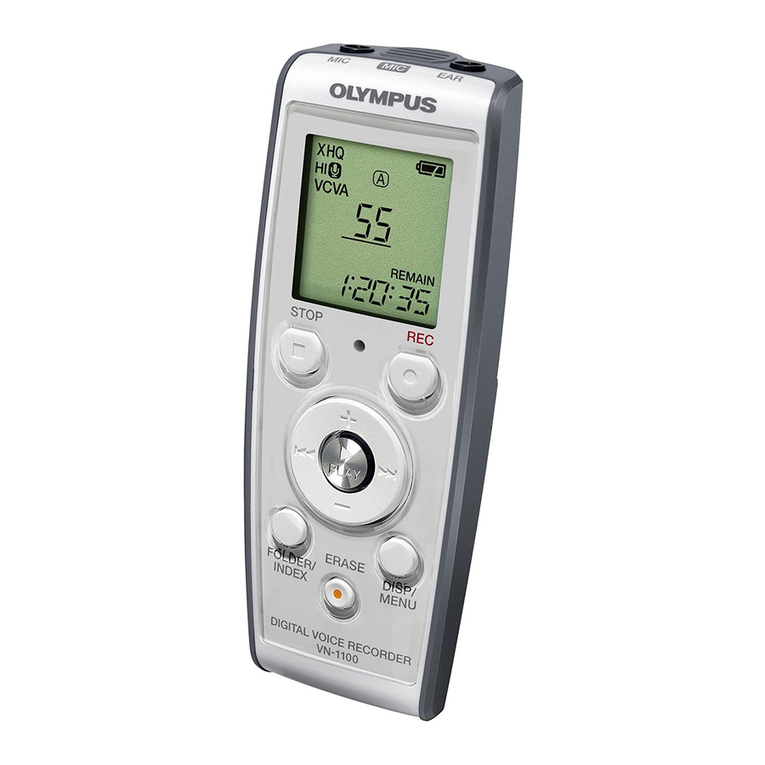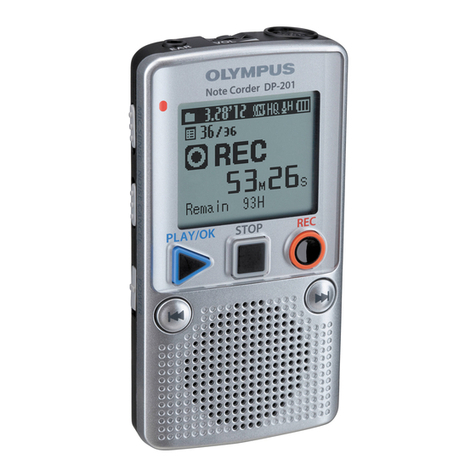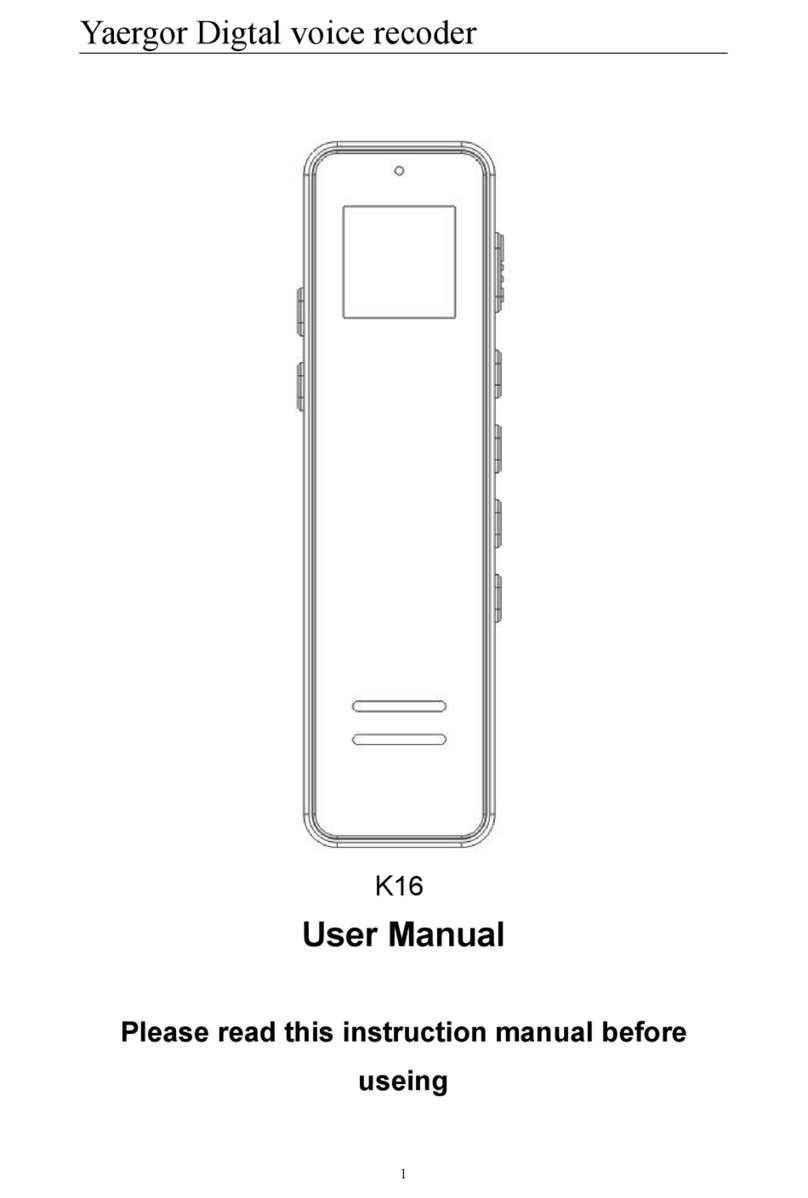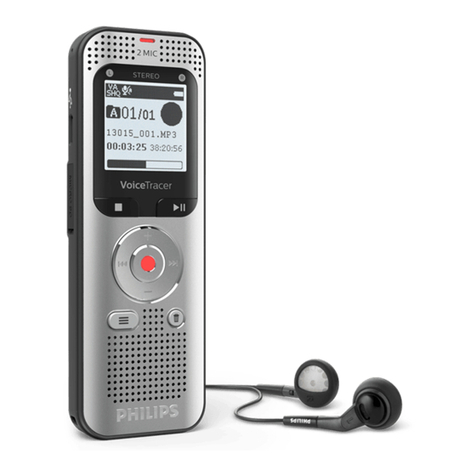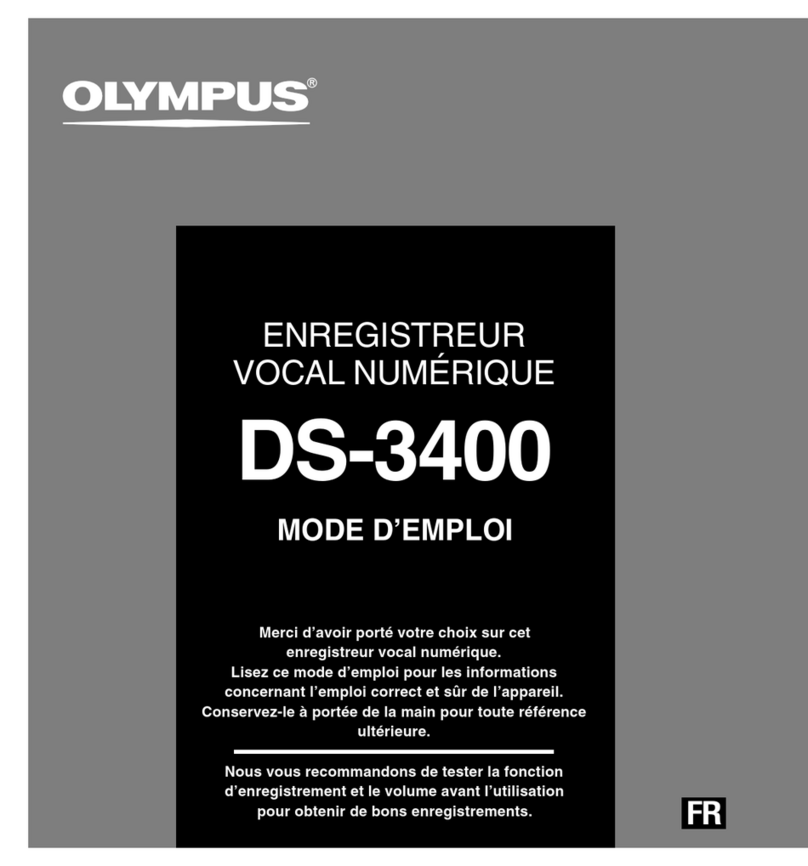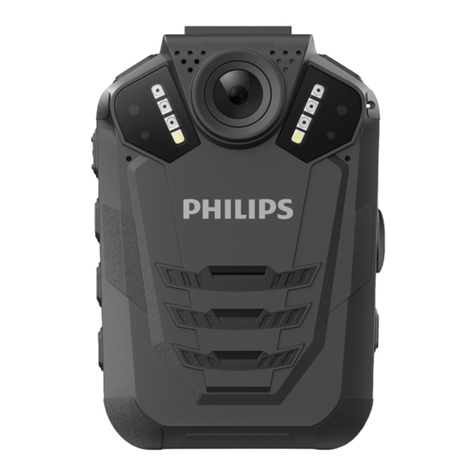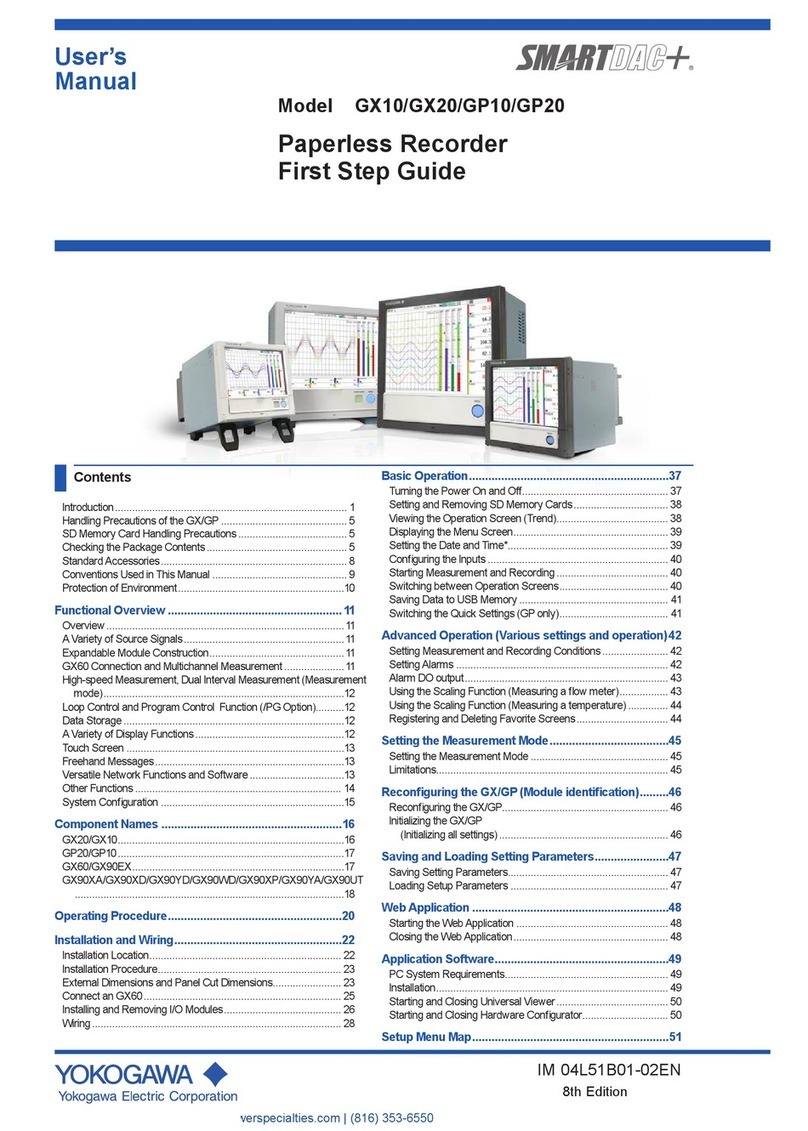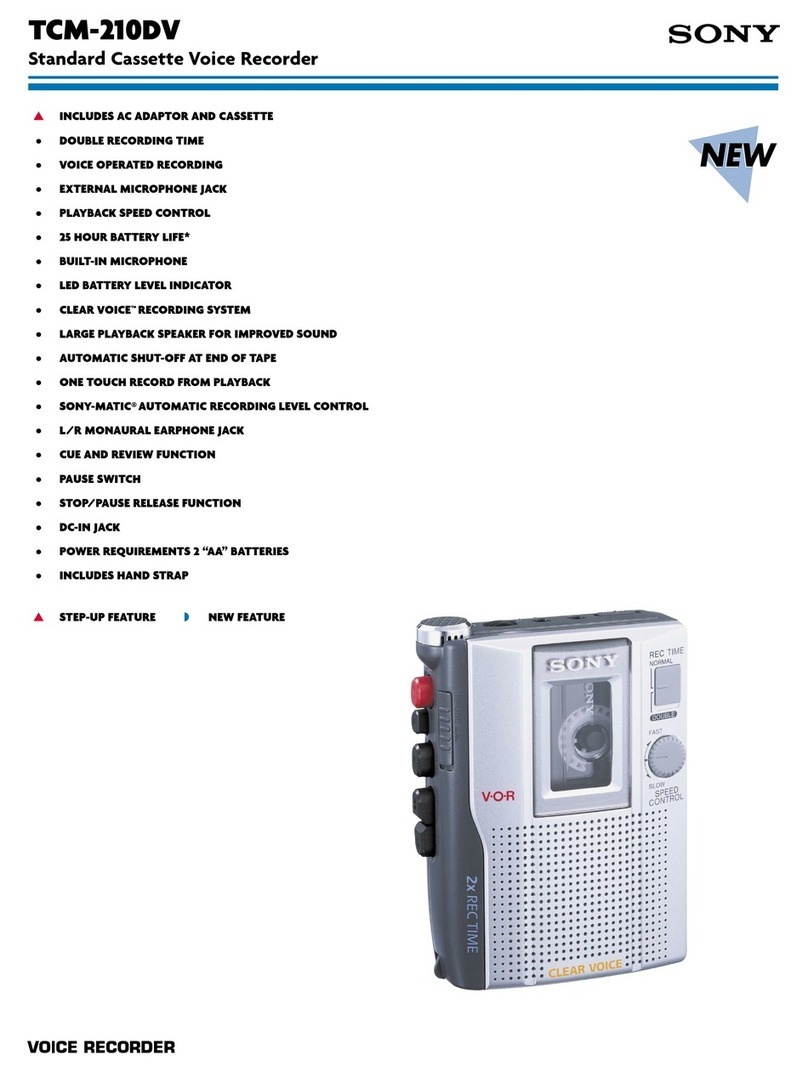telog R-3000 Series User manual

Telog Data Recorders
User Guide
R-3000 Series
Telog Instruments, Inc.
830 Canning Parkway, Victor, NY 14564-8940 USA
Phone: (716) 742-3000 • Fax: (716) 742-3006
Website: http://www.telog.com

Telog Part No.: 3000-051 Rev D
Released 4/99
Information in this document is subject to change without notice and does not represent a commitment on the part of
Telog Instruments, Inc. Although every effort has been made to insure the accuracy of this documentation, Telog
Instruments cannot be held liable for any errors. No part of this manual may be re-produced or transmitted in any form or
by any means, electronic, mechanical, including photocopying and recording, for any purpose other than the purchaser’s
personal use without the written permission of Telog Instruments, Inc.
Telog is the registered trademark and Level Tracker and Telogers are trademarks of Telog Instruments, Inc.
Tefzel is a registered trademark of the Dupont Company.

Preface
Telog Data Recorders i
Table of Contents
List of Tables.........................................................................................................................................................iii
List of Figures........................................................................................................................................................iv
Assumptions ...........................................................................................................................................................v
Feedback to Telog ..................................................................................................................................................v
Product Registration ...............................................................................................................................................v
Organization of this Guide......................................................................................................................................v
Unpacking Your System........................................................................................................................................vi
Cleaning Your System...........................................................................................................................................vi
Section 1. Telogers:
R-3000
Series
Recorders .........................................................................1–1
Overview ............................................................................................................................................................1–1
Specifications .....................................................................................................................................................1–2
Analog Channel Inputs .......................................................................................................................................1–4
Input Types...........................................................................................................................................1–4
Voltage..........................................................................................................................................1–4
Current loop ..................................................................................................................................1–4
RTD ..............................................................................................................................................1–5
Thermocouple ...............................................................................................................................1–5
Ambient Temperature ...................................................................................................................1–5
Excitation .............................................................................................................................................1–5
Procedure to perform a calibration test .........................................................................................1–6
Schematics............................................................................................................................................1–7
Digital Channel Inputs......................................................................................................................................1–10
Summary ............................................................................................................................................1–10
Pulse............................................................................................................................................1–10
Event ...........................................................................................................................................1–10
Installation considerations..................................................................................................................1–10
Schematics..........................................................................................................................................1–11
Data Collection.................................................................................................................................................1–12
Power Options ..................................................................................................................................................1–13
Summary ............................................................................................................................................1–13
Battery Life Considerations................................................................................................................1–14
Procedure to compute battery life ...............................................................................................1–14
Alarms ..............................................................................................................................................................1–16
Modem Module ................................................................................................................................................1–18
Procedure to install the modem..........................................................................................................1–18
General U.S. FCC information...........................................................................................................1–18
Canada Department of Communications Notice ................................................................................1–19

Preface
Telog Data Recorders v
Assumptions
This User Guide contains information for setting up the Telog R-3000 series, R-2100 series
and LC-800 series data recorders. This guide provides information on hardware features that
are appropriate when using Telogers for Windows for programming and collecting data using
these recorders. For information on using the support software appropriate for your type(s) of
recorder(s), refer to the corresponding user guide: for S-3PC use the Telogers for Windows
User Guide, for S-21PC use the R-2100 Series User’s Manual and for S-8PC use the
Linecorder LC-800 Series User’s Manual.
Feedback to Telog
All of our products are the result of efforts by the engineering, marketing, and production
staffs of Telog Instruments, Inc. We are eager to know what you think of our recorders, the
software and our user guides. We are constantly seeking ways to improve our products based
on your comments and experiences. Many of our ideas for improvement to existing products
and ideas for new products come from you. Call, fax or write to use at the information on the
front cover.
Product Registration
To register your recorder(s) and software with Telog, complete and return the registration card
located in the front of this guide. We provide technical support for registered users. In
addition, we notify registered users of product upgrades and may offer you the opportunity to
purchase upgrades at substantial savings.
Organization of this Guide
This guide contains a section for each series of Telog's recorders and the optional Data
Transfer Unit. You will find information for installation, setup, use and specifications for each
type of recorder. Refer to the table of contents for the section that describes the type of
recorder(s) for which you want information.

Preface
vi Telog Data Recorders
Unpacking Your System
Some suggestions for unpacking your system are provided below.
•Please unpack each package of the shipment carefully. Be sure to remove all items. Small
items such as cables and batteries are easily overlooked.
•Compare the total received shipment contents with the packing list. Contact Telog if items
are either missing or different from the packing list.
•Save the shipping cartons, boxes, etc. They can be reused if you need to return a recorder
for service.
•Carefully inspect all items for shipping damage.
If you received a sensor or transmitter with your recorder, inspect the sensing elements by
unscrewing the black plastic tip of the sensor or transmitter and visually inspect the
crystal diaphragm for cracks or other obvious physical damage, then replace the tip.
•Do not attempt to install or use any damaged item. If items were damaged in shipment,
contact the shipper for assistance.
Cleaning Your System
Information for routine cleaning of Telog recorders is provided here. Additional information
for cleaning and decontaminating e-series recorders if they are exposed to known or potential
health hazards is described in Section 3.
Note: Telog reserves the right to withhold service from any product until proper
cleaning and decontamination have been accomplished and certified.
To perform routine cleaning, wipe the enclosure of the recorder with a water-dampened cloth.
If needed, use a mild detergent, then wipe the detergent with a water-dampened cloth. Wipe
excess water from around the connectors. Allow the water to evaporate thoroughly before
returning the recorder to service.

Telogers: R-3000 Series Recorders
Telog Data Recorders 1–1
Section 1.
Telogers:
R-3000
Series
Recorders
Overview
The Telogers data acquisition system is designed to perform automatic data collection from
remote locations. A minimum system configuration consists of at least one R-3000 series
(Teloger) recorder, Telogers for Windows (S3-PC) support software running on a personal
computer and a data transfer cable (C-21ATC). A more common system configuration
consists of several (five, 50, or even 300) Telogers sharing Telogers for Windows.
There are several models of Teloger recorders in the R-3000 recorder series. The model
number identifies the number of independent channels for data collection. Appendix A and
Table 1-1 provide information on each model in the R-3000 series, sensors and accessories for
a Telogers system.
Each Teloger consists of a circuit board packaged in a bent metal enclosure for panel
mounting. The recorder’s face-plate contains information on connections for power, telephone
and signal inputs. Optional NEMA 4X enclosures are available to fit your specific application
requirements.
Program each R-3000 using Telogers for Windows. The R-3308 recorder channels are
completely software programmable. The R-3307 and R-3314 recorders have hardware
switches that set the analog channels to collect either current or voltage information. The
R-3303 recorder does not have analog channels. Information on setting the hardware switches
is provided later in this section.
If your R-3000 Teloger has the optional M-324 modem module or an external modem, you
can reprogram and collect data using remote communications. If the recorder does not contain
the module or an external modem, use the data transfer cable for local (direct) connection to
the computer running Telogers for Windows (S3-PC) to program and collect data.
Refer to the Telogers for Windows User Guide for information on setting up, programming
and collecting and analyzing data from an R-3000 recorder.

Telogers: R-3000 Series Recorders
1–2 Telog Data Recorders
Specifications
Table 1-1. R-3000 Series Recorder Specifications
R-3314 R-3308 R-3307 R-3303
Recorder Channels
Channels 14 total - 8 analog and
6 pulse/event
8 total - 4 analog, 3
pulse/event and 1
ambient temperature
7 total - 4 analog and 3
pulse/event
3 total, pulse or event
Memory 256K or 512K RAM total, dynamically allocated among active channels
Analog inputs only 127,980 or 289260
12-bit data values
137,700
12-bit data values
70,560 or 151,200
12-bit data values
NA
Pulse inputs only 95,985 or 216,945
16-bit data values
103,275
16-bit data values
52,920 or 113,400
16-bit data values
52,920 or 113,400 16-bit
data values
Event inputs only 31,995 or 72,315 events
34,425 events 17,640 or 37,800
events
17,640 or 37,800 events
Storage Wrap-around (FIFO, first-in, first-out)
Analog Inputs Type User selectable NA
Voltage Bipolar or unipolar: 100 mV, 200 mV, 500 mV, 1, 2, 5, 10, or 20 V; or
unipolar 1–5 V
Current Bipolar or unipolar: 1mA, 20 mA; or unipolar 4-20 mA
Ambient temperature
RTD NA NA
Thermocouple
See Table 1-2 that
follows
Input Impedance
Voltage input 1Mohm to ground (+ and – inputs)
Current mode 200 ohms loop
impedance
100 ohms loop
impedance
200 ohms loop
impedance
Common Mode Rejection
± 4 Vdc on 1V or lower voltage ranges and 1 ma current range
± 40 Vdc on 2V or higher voltage ranges and 20 ma current range
Excitation NA On time for 5 ms to 400
ms; voltage or current,
selectable to suit
transmitter used: 5 or
12 volts (20mA max.),
or 1mA (1Vmax)
NA
Resolution 12 bits (0.025% of FS)
Accuracy ± 0.05% for 100 mV ranges and above; ±0.1% for ranges below 100mV;
±50ppm/°C
Analog and Temperature Sampling
Sample rate Once/s to once every 8 h for each channel
Sample interval 1 s to 8 h, synchronized to midnight, channel independent
Values saved Minimum, average and/or maximum per interval
Totalizers 1 six-byte totalizer per channel

Telogers: R-3000 Series Recorders
Telog Data Recorders 1–3
Table 1-1. R-3000 Series Recorder Specifications (cont.)
Pulse/Event Inputs
Type Pulse counting or event recording, user selectable
Input Uncommitted contact or active logic signals
Excitation 10µA contact sensing current; 5 volt pull-up
Contact bounce 3 ms, software programmable bounce filter
Pulse Sampling
Low speed rate 100/s with bounce filter
High speed rate 20,000/s with no bounce filter
Total interval 1 s to 8 h, synchronized to the hour, channel independent
Values saved Totals, overall and per interval
Event Sampling
Event rate 1 event/s maximum
Values saved Event with time stamp (mm:dd:yy:hh:mm:ss), and computed run time
Alarms
Activation any channel
Outputs for R-3303 and R-3307: 1 high and 1 low; for R-3308 and R-3314: high/high, high, low and low/low
Type Open collector transistor
Maximum voltage 30 V
Maximum current 100 mA
Resolution 0.025% of FS
Power
Local battery type and
life
Lithium battery pack with MTA connector: 10V 1.8Ah pack for R-3303, R-3307 and R-3314, 9V
3.6Ah pack for R-3308.
Life of 6 months @ 23°C, with 1 sample every 5 s on all channels and one minute phone call/day. Refer
to “Power Options” later in this section for additional information.
External Battery For R-3303, R-3307, R-3314, 11.5Vdc to 15 Vdc. For R-3308, 10Vdc to 15Vdc.
External DC, unregulated
15-35 Vdc
Communications
Type RS-232 (opto-isolated), standard
Baud rate 300, 1200, 2400, 9600
Connector 9-pin ‘D’ connector, compatible with Telog C-21AT
Modem option 2400-baud plug-in module, FCC and CSA approved
Mechanical & Environmental
Clock accuracy + 0.01%
L
ED
indicator With external power 1 flash every second. On battery power, 1 flash every 5 seconds for R-3308 & R-
3314 and 1 flash every second for R-3303 & R-3307.
Operating temperature -20 to 60°C
Enclosure Bent aluminum panel mount assembly
Size for R-3303, R-3307 and R-3308, 21.6 cm x 17.2 cm x 5.7 cm / 8.5” x 6.8” x 2.3”
for R-3314, 20.9 cm x 25.2 cm x 5.7 cm / 8.2” x 9.9” x 2.3”
Options Fiberglass, IEC IP65, NEMA 4X enclosures, contact factory

Telogers: R-3000 Series Recorders
1–4 Telog Data Recorders
Table 1-2. R-3308 Analog Inputs
Measurement Range Resolution (average) Accuracy
Ambient temperature*
(Telog AT-4 sensor)
0 to 70°C
-20°C to 80°C
0.2°C
0.3°C
±0.4°C
±0.6°C
RTD** (100ohm Pt, α= 0.00385)
Range 1
Range 2
-220°C to 850°C
-220°C to 260°C
0.4°C
0.15°C
±1.5°C
±0.6°C
Thermocouple**
Type K -80 to 1200°C 0.7°C ±3.5°C
Type E -80 to 660°C 0.4°C ±2°C
Type T -80 to 350°C 0.3°C ±2°C
Type J 0 to 750°C 0.5°C ±3°C
Type R 0 to 1450°C 1°C ±6°C
* Ambient temperature measurement accuracy does include sensor error for AT-4 sensor.
** RTD and thermocouple measurement accuracy does not include error of sensor.
Analog Channel Inputs
Input Types
The analog channels on the R-3307and the R-3314 have hardware switches you must set to
measure either voltage or current, then use Telogers for Windows to select the same input.
Four of the R-3308 analog channels can be set for current loop, voltage (with pulsed
excitation) or RTD input. An fifth analog channel is dedicated to ambient temperature input.
Voltage
Each voltage input terminal appears as a 1MΩinput to the recorder’s ground and allows for
differential measurement of voltage between the + and – terminals in the presence of common
mode voltage. The maximum common mode voltage that can exist at each input without
introducing measurement error is a function of the range and is described in Table 1-3 and
shown in Figure 1-1.
Table 1-3. R-3000 Analog Voltage Inputs
Selected input range Maximum common mode range
1V or less ±4V
2V or more ±40V
Current loop
Current measurement is performed by measuring the voltage across an internal shunt resistor
between the + and – input terminals. This resistance produces a burden voltage to the current
loop as described in Table 1-4.
The shunt resistance is comprised of a series precision resistor and a positive temperature
coefficient (PTC) resistor. If the input current exceeds 80mA, the PTC resistor will increase
resistance rapidly to protect the precision resistor. When external excitation is removed, the
PTC resistor returns to its original resistance value. When in current mode, the maximum
voltage that can be applied across the input terminals without causing damage to the precision
shunt is 30V. Refer to Figure 1-2 for schematics.

Telogers: R-3000 Series Recorders
Telog Data Recorders 1–5
Table 1-4. R-3000 Analog Current Inputs
Recorder type Shunt resistance Maximum burden voltage
1 mA range 20 mA range
R-3307, R-3314 200ohms 0.2V 4V
R-3308 100ohms 0.1V 2V
RTD
The R-3308 recorder supports 3-wire and 4-wire 100Ωplatinum RTDs with α= 0.00385.
Three-wire RTDs require the addition of a jumper between the excitation and + terminals. The
recorder automatically performs pulsed excitation, lead-wire resistance correction and
linearization for RTD inputs. Refer to Figure 1-3 for schematics.
Thermocouple
The R-3308 recorder supports five types of thermocouples: J, K, T, E and R. Thermocouple
inputs are polarized. The recorder automatically performs cold-junction compensation and
linearization for thermocouple inputs. Refer to Figure 1-4 for a schematic.
Ambient Temperature
The R-3308 recorder can measure ambient temperature (-20 to +80°C) on channels 1–5 with
the Telog ambient temperature probe (AT-4). Channel 5 is dedicated to this measurement.
Refer to Figure 1-5 for schematics.
Excitation
The R-3308 analog channels provide pulsed excitation to power external sensors and
transmitters on all channels. Pulsed excitation permits the recorder to excite or power certain
external sensors and transmitters to minimize power consumption, specifically when the
sensor and recorder are powered by batteries. For example, a 4-20mA transmitter, which may
consume as much as 240mW if continuously powered, may consume, on average, only 240µW
(1000 times less) if the measurement can be taken once every 10sec with an excitation period
of 10ms.
If external power is available to the recorder and sensor, it is not necessary to use the pulse
excitation feature. (Standard connection diagrams, when excitation is not employed, are
provided in Figures 1-1 and 1-2.)
The excitation is user-selectable as 5V, 12V, or 1ma with a programmable duration from 5 to
400ms. The maximum current for 5V and 12V excitation is 20mA. The maximum output
voltage for 1ma excitation is 1V.
Some applications using pulsed voltage excitation are described in the list below. The
recommended connections for each application are shown in illustrations in Figure 1-6.
•A 2-wire current loop transmitter. Note that a 12V excitation pulse provided to a remote
current loop transmitter results in only 10V available for the transmitter since as much as
2V will be dropped across the R-3308 current shunt resistance.
•A 3-wire voltage sensor/transmitter where the signal return is also the negative supply of
the sensor. You must supply a connection between the recorder terminal and the ground
terminal.
•A resistance bridge network in the range of 250 to 50,000 ohms.
•A 4-wire voltage sensor/transmitter where the output signal is independent of the negative
supply to the sensor.
•A 3-wire potentiometer in the resistance range of 250 to 50,000 ohms with 5V excitation.
We recommend 5V excitation. The system determines the wiper position as a percent of
full-scale travel.

Telogers: R-3000 Series Recorders
1–6 Telog Data Recorders
For proper measurement when using the pulse excitation feature, select an appropriate
excitation pulse duration. The R-3308 supports sensors that respond rapidly to applied
external power and achieve a stable output within 400msec, the maximum excitation period.
Some sensors, for example, the Druck PTX 1830 Pressure Transmitters, produce the specified
accuracy in 10msec. However, some transducers require in excess of one second to achieve a
stable output level, and hence, cannot be used with the R-3308.
If you are not certain the sensor you want to use can be supported by the R-3308 pulse
excitation feature, use one of the following three methods:
•Refer to the sensor manufacturer’s information or contact the manufacturer. (The
excitation period typically is not a standard sensor specification.)
•Contact Telog’s Customer Service Department for information on known compatible
sensors.
•Perform the simple calibration test described below.
Procedure to perform a calibration test
1. Connect the sensor to an appropriate calibrator input and to the R-3308 analog input
channel.
2. Provide the sensor with a continuous source of external power (5V, 12V, or 1ma).
3. Document the calibrated output signal level on the R-3308.
4. Replace the external power source with the R-3308 excitation source programmed for 400
msec pulse duration at 10 sec intervals.
5. Repeat step 4 using progressively shorter pulse duration values until you detect a
departure from calibration.
6. Select the shortest pulse interval that produces reliably stable calibrated measured values.
7. Repeat this calibration test (steps 1 — 6) at multiple points over the amplitude range to
ensure that the sensor responds correctly independent of input signal level.

Telogers: R-3000 Series Recorders
Telog Data Recorders 1–7
Schematics
This section contains analog channel schematics.
3-wire or
self-powered
transmitter
External
power
Recommended
To A/D
converter
+
–
+
+ –
+
–
( )
GND
4-wire or
self-powered
transmitter
External
power
Recommended
To A/D
converter
+
–
+
–
+ –
+
–
( )
GND
Three-wire voltage transmitter Four-wire voltage transmitter
Figure 1-1. R-3000 Voltage channel schematics
External
power
Recommended
To A/D
converter
R= 50 for R-3308,
100 for R-3307 and R-3314
Ω
Ω
PTC
R
+
–
+ –
+ –
+
–
( )
GND
External
power
4-wire or
self-powered
transmitter
Meter or
display
Recommended
Optional
To A/D
converter
R= 50 for R-3308,
100 for R-3307 and R-3314
Ω
Ω
PTC
R
+
–
+
–
+ –
+ – +
–
( )
GND
Two-wire current loop transmitter Four-wire current loop transmitter
Figure 1-2. R-3000 Current transmitter schematics
+
–
3-wire
100
Ω
RTD
To A/D
converter
(E)
(+ )
(–)
( )
GND
I
+
–
4-wire
100
Ω
RTD
To A/D
converter
(E)
(+ )
(–)
( )
GND
I
Three-wire Four-wire
Figure 1-3. R-3308 RTD input schematics

Telogers: R-3000 Series Recorders
1–8 Telog Data Recorders
+
–
J, K, T, E or R
Thermocouple
To A/D
converter
(E)
(+ )
(–)
( )
GND
Figure 1-4. R-3308 Thermocouple input schematic
Temperature
sensor
(E)
(+ )
(–)
( )
GND
+
–To A/D
converter
AT-4
I
Temperature
sensor
(E)
(+ )
(–)
+
–
To A/D
converter
AT-4
+ 5 V
For Channels 1-4 For Channel 5
Figure 1-5. R-3308 Ambient temperature input schematics

Telogers: R-3000 Series Recorders
Telog Data Recorders 1–9
+
–
To A/D
converter
50
Ω
PTC
Out (–) Out (+ )
+ 5V (20mA max.)
(E)
(+ )
(–)
( )
GND
E(+ )
E(–)
out
+ 5 V
or
+ 12 V
To A/D
converter
(E)
(+ )
(–)
( )
GND
+
–
+
–
Four-wire resistance bridge Four-wire voltage transmitter
(E)
(+ )
(–)
( )
GND
+
–
To A/D
converter
Jumper
+ 5 V
Out
+ 5 V
or
+ 12 V
To A/D
converter
Jumper
Out
(E)
(+ )
(–)
( )
GND
+
–
Three-wire potentiometer Three-wire voltage transmitter
– +
(E)
(+ )
(–)
( )
GND
+
–
To A/D
converter
Jumper
PTC
50
Ω
+ 12 V
Two-wire 4-20ma current loop transmitter
Figure 1-6. R-3308 Pulsed excitation applications

Telogers: R-3000 Series Recorders
1–10 Telog Data Recorders
Digital Channel Inputs
Summary
The R-3303, R-3307 and R-3308 each have three digital channels and the R-3314 recorder has
six digital channels for pulse or event recording. Refer to Table 1-1 for additional information.
Pulse
The pulse input mode is useful for counting the number of pulse events that occur during
sequential intervals. For example, it can count the number of times a tipping bucket rain gage
tips per hour or the blade rotations of a turbine meter per minute. Each pulse event can be
scaled into the appropriate engineering units of measure. Hence, you can converts tips of the
bucket rain gage into inches of rainfall per tip, and more appropriately, inches of rainfall per
hour. The rotations per minute of a turbine meter can be converted to a flow rate, such as
gallons per hour (gph).
The digital inputs may interface either uncommitted mechanical contacts such as switches or
relay contacts, actively driven logic or transistor inputs, as shown in Figure 1-7. When
interfacing mechanical contact inputs, select the low-speed pulse input, which employs a
3msec contact bounce filter, to eliminate false counting of contact switch bounce. The high-
speed pulse selection does not employ an input filter; use it when monitoring high rate events
such as turbine meters or radiation counters.
Event
The event input mode records the date and time, to one-second resolution, of a contact closure
and/or opening, or the positive and/or negative transition of an analog logic signal. This is
useful for recording pump and motor run-time or logging the time-stamp of critical events. For
additional information refer “Installation considerations”.
Installation considerations
Generally, sensors or systems that produce actively-driven digital output signals have low
impedance outputs and are less susceptible to electromagnetic interference than uncommitted
contacts or open-collector transistor circuits which use passive pull-up resistors. As a general
rule, actively-driven logic signals can be satisfactorily interfaced at cable lengths of 2000ft
(600m) while uncommitted contacts (or open-collector transistor circuits) should be less than
100ft (30m).
The pulse/event input circuit employs a high impedance pull-up resistor (350K ohms) to
+5VDC to detect contact closures to ground. In applications where the environment is
electrically noisy or where the input cable distance exceeds 100ft (30m), add an external
resistor and capacitor network with external DC excitation as illustrated in Figure 1-7 to
improve the signal integrity. The external excitation may be the recorder’s external power
supply input or any DC voltage greater than 5VDC up to a maximum of 30VDC.
When interfacing active logic inputs (shown in Figure 1-7) select the high-speed pulse input to
count pulses as short as 50µsec or frequencies as high as 20KHz. Very short pulses must have
high and low periods of at least 25µsec to be detected. The recorder’s detection threshold for
the pulse/event inputs is 2.5VDC ±1VDC.

Telogers: R-3000 Series Recorders
Telog Data Recorders 1–11
Schematics
This section contains digital channel schematics.
Contact
source
Software
controlled
filter
to
counter
circuit
Digital
input
+
–
Digital
input
340K
Ω
10K
Ω
0.1µF
+ 5V
+ 5V
+ 5V to 30V
+ Digital input
– Digital input
Digital input circuit with contact input Active logic inputs
control
+ Digital input
– Digital input
Contact
source
+ 5V to 30V
Long lines
Long lines
27K
Ω
0.1µF
+ Digital input
– Digital input
Open collector transistor input Low impedance setup with external resistor and
capacitor
Figure 1-7. R-3000 Digital input circuits

Telogers: R-3000 Series Recorders
1–12 Telog Data Recorders
Data Collection
Since each channel has separate signal inputs, you can program parameters including channel
information, recording and alarm parameters, phone settings and security options for each
channel independently using Telogers for Windows. After downloading the channel
parameters to the recorder, data collection begins using these parameters.
After recorder installation, each active channel samples its input signal at the programmed
sample rate. At the end of a sampling interval, the recorder:
•fetches a reading from each active channel.
•for each analog channel, compares the current reading with the highest and lowest
readings that have occurred for that recording interval. If a new minimum or maximum
value occurred, the recorder discards the old value and stores the new value in an
intermediate buffer.
•adds the reading to an intermediate summation register.
If programmed, at the end of each recording interval, the recorder:
•determines the minimum and/or maximum values for each channel and stores them.
•for each analog channel, computes the average (intermediate summation register / number
of samples taken during the recording interval), rounds the value, and stores it. (Inputs on
pulse channels are not averaged.)
•updates the totalizer register (channel average x number of seconds in the interval) and
stores the value.
•clears the intermediate summation register.
At midnight (standard time) the recorder stores a snapshot of the current totalizer value in
memory. The recorder maintains a buffer of the most recent 40 days of totalizers for each
totalizing channel. The contents of the totalizing buffer is transferred to your computer during
routine data transfer.
The time stamps reported for each recorded interval correspond to the start time of a recording
interval. For example for a 15 minute recording interval, data reported at 12:00 am was
obtained between midnight and 12:14:59 am.

Telogers: R-3000 Series Recorders
Telog Data Recorders 1–13
Power Options
Summary
Each Teloger recorder has three power inputs: local battery, external battery and external
unregulated DC. Each input is described in Table 1-5 and represented in the schematic in
Figure 1-8.
Table 1-5. R-3000 Summary of Power Inputs
Power Source /
Input
Applications Notes
Local battery External power is not available at the
monitoring site. (In typical applications
local battery can power recorder and
modem for six months. For the R-3308,
pulse excitation can occur.)
External power to recorder fails.
Lithium battery pack shipped with recorder (10V for R3303,
R3307 and R-3314 and 9V for R3308).
Operating temperature: -40°to 70°C.
Shelf life is greater than 8 years, but replacement recommended at
five years, or more frequently, if primary power source.
Refer to Tables 1-6 and 1-7 for battery life calculations.
External battery 12V battery.
Solar panel rechargeable battery system.
Regulated
DC
power supply.
Battery voltage range for R-3303, R-3307, R-3314 should be 11.5
to 15V
DC
. If voltage drops below 11V
DC
, local battery becomes
power source.
Input voltage range for R-3308 should be 10 to 15V
DC
. If voltage
drops below 9.5V
DC
, local battery becomes power source.
Input voltages above 16V
DC
may damage this power input circuit.
Unregulated dc
input
(15 to 35 V
DC
)
24V
DC
power supplies.
Unregulated
AC
to
DC
converters.
Any
DC
power source with a range of 15-
35V
DC
.
Power sources connected to this input are conditioned by a
voltage regulator that consumes 5ma continuous current for R-
3303, R-3307, R-3314 (2ma for R-3308).
If input voltage drops below 15V
DC
, external battery, if provided,
then local battery, will become power source.
Voltages above 36V
DC
may damage this power input circuit.
+
–
+
–
+
–
1 0 Vd c
(9 V o n R -3 3 0 8 )
lo c al
b atter y
lo w p o w er
reg u lato r
external
b atter y
reg u lato r
+ 5 V
+ 1 4 V
D C p o w er
s u p p ly
1 5 -3 5 Vd c
Po w e r DC +
( 1 2 vo lts )
Po w e r DC +
(1 5 to 3 5 Vd c )
Po w e r DC -
( g ro u n d )
Figure 1-8. R-3000 External power inputs

Telogers: R-3000 Series Recorders
1–14 Telog Data Recorders
Battery Life Considerations
Since user applications vary widely and each may place a different set of demands on the
recorder’s power requirements, it is not possible to provide a single value for the battery life
expectation. However, for long-term battery-powered monitoring applications, you should
determine, in advance, the battery requirement needs. In general, the factors affecting the rate
of battery consumption are:
•Sampling current. The frequency of sampling and current consumed when performing
measurements or computations.
•Communications current. The current consumed when the modem is communicating with
the host computer by phone (land-line or cellular).
•Excitation current (R-3308 only). The current required to produce the pulsed excitation
power for remote sensors and transmitters.
•Background current. The continuous current consumed by the recorder when not
performing the above tasks.
The supplied local battery will power the recorder for six months when sampling occurs at 5
second intervals and calling occurs once per week for 5 minutes. A faster sampling rate, more
frequent phone calls, or exciting external sensors (R-3308 only) will shorten the battery life.
Computing the battery life, or power requirements, for different applications with the R-3303,
R-3307 and R-3314 recorders is described in the next topic. For additional information
regarding a specific application, contact Telog Customer Service.
Computing battery life for the R-3308 is substantially more complex than that for other R-
3000 series recorders because of the programmable excitation feature and, therefore, it is not
provided here. At the time this User Guide went to press, Telog was developing a software
utility program that will allow you enter a set of recorder parameters and obtain the battery
life, or power requirements, for an operating period. This utility will be posted on Telog’s web
site (www.telog.com) as soon as it is available. In the meantime, please contact Telog
Customer Service for specific questions related to this issue.
Procedure to compute battery life
This procedure computes the battery life for your recorder (R3303, R-3307 or R-3314) based
on its current configuration. The local battery life is its power capacity divided by the power
demands placed on the recorder.
monthfunctionsbackgroundionscommunicatsamplingusedpower
capacitypower
LifeBattery
/)( ++
=
The example used in this section calculates the battery life for an R-3307. This recorder
records on two channels set for 5-second sampling intervals and store three statistics per
15-minute recording interval. The recorder is programmed to call once a week to transfer data.
Table 1-6 describes each step of this computation and Table 1-7 shows the actual calculation
of battery life for this example. At the end of Table 1-7, we find the recommended time for a
battery check and/or change would be nine months.

Telogers: R-3000 Series Recorders
Telog Data Recorders 1–15
Table 1-6. Computation of battery life
Step Resulting
parameter
Recorder setting /
Value
Multiplier or addition
Notes
1 A
power used for
sampling each
month
(mAh/month)
# of
samples/minute
(value entered in
Telogers for
Windows)
x sampling
power/month per
sample/min factor
The more frequently data samples are collected, the higher the
value of A.
Factor is: For R-3303, use 2.2; For R-3307, use 3.7; For R-
3314, use 12.4.)
2 B
(# of data values)
# of statistical
values stored
x recording interval/hr
x # channels x # of
days between calls
As an example, an R-3307 is using two channels set to sample
at 5 second intervals and store three statistics per 15-minute
recording interval. This produces 3 values/rec int x 4 rec int/
hr x 2 channels, or 24 values/hr. If the recorder is programmed
to call once a week, the amount of data to be transferred is
computed using 24 values/hr x 24 hr/day x 7 day/wk, or 4032
values.
3 C
estimated call
duration
(seconds)
B
x 2.1 bytes ÷ (baud
rate/10)
+ 45 seconds
Call duration includes time to establish a comm. session (45
seconds is the average time required for telephone switching
and computer log-in) and time for data transfer. Although
different types of data take up different amounts of byte space,
we use a conservative estimate that each value takes up 2.10
bytes.
Actual time for data transfer is obtained by dividing the baud
rate (in bytes/second) by the amount of data to be transferred
(in bytes). Although a baud is a bit/second or 1/8 byte/second,
we use a value of 10 to allow for the start and stop bits that get
added to each value transferred.
4 D
total monthly call
time
(minutes/month)
# of calls/month
(use values
entered in
Telogers for
Windows)
x estimated call
duration (in minutes)
The more frequent the recorder calls, the higher the value of
D.
5 E
power used for
calling each
month
(mAh/month)
D x recorder
communications power
usage factor
Power usage factors are: For R-3308, use 0.75: For R-3307,
use 0.833; For R-3314, use 1.17.
6 F
total battery power
used each month
(mAh/month)
A + E + 100 mAh/month
(background power
consumption)
This is the sum of the main power usage: power used for
sampling each month (A), used for calling out each month and
used for background tasks.
7 G
calculated battery
life (months)
1800 mAh
÷
F 1800Ah is the power capacity of the battery pack used in R-
3303, R-3307 and R-3314.
8 Battery Life
(months)
G x 80% (safety factor) For a conservative estimate, use the safety factor.
Table 1-7. Example computation of battery life
Step Calculations Calculated parameter
1 12 samples/min x 3.7 samples/min/mAh/month = 44.5 mAh/month (A)
2 3 statistics x 4 rec interval/hr x 2 channels x 24 hours/day x 7 days = 4032 values/call
3 [(4032 values x 2.1) ÷ (2400 baud/10)] +45 sec = 80.28 sec or 1.34 min
4 4 calls/month x 1.34 min/call = 5.35 min/month (C)
5 C x 0.833 mAh/min = 4.46 mAh/month (D)
6 A + D +100 mAh/month = 148.96 mAh/month (E)
7 1800 mAh
÷
E = 12.08 months (F)
8 F x 80% = 9.66 months
Table of contents

